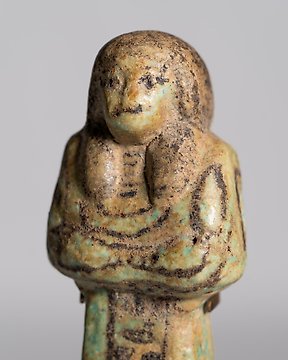
Égypte ancienne, Nouvel Empire Ushabti surveillant en faïence du Grand Prêtre "Nuit de Ramsès", 12,8 cm - Licence d'exportation Shabti
Nº 79799783

Nº 79799783

Description
Amulette représentant le faucon Horus
Fritte emaillée
most probably dating from the new kingdom, or 20th - 21st dynasty.
Description:
Horus, the falcon-headed god of ancient Egypt, held a variety of significant roles, including his association with the sky, kingship, protection, and healing. The abundance of Horus amulets can be attributed to his diverse and vital functions in Egyptian religion and culture, as well as his enduring popularity among the Egyptian populace.
Horus is one of the most significant and enduring deities in ancient Egyptian mythology. He is often depicted as a falcon-headed god, a representation that symbolizes his association with the sky, kingship, and protection. The falcon's eyes in his depictions are particularly noteworthy, with one eye representing the sun (the "right eye of Horus," or the "Eye of Ra") and the other representing the moon (the "left eye of Horus"). This duality is indicative of his role as a solar and lunar deity, embodying both divine and earthly powers.
Roles of Horus in Ancient Egypt:
Sky God and Solar Deity: Horus was closely associated with the sky and the sun, often depicted as a falcon soaring high above the Earth. As a solar deity, he represented the life-giving and illuminating qualities of the sun, symbolizing the Pharaoh's divine right to rule as the intermediary between the gods and the people.
Protector and Warrior: Horus was revered as a god of protection and a fierce warrior. He was seen as a defender of the Pharaoh and Egypt itself. One of his most famous myths involves his battle against Seth, the god of chaos and disorder, to avenge his father Osiris's murder and restore order to the cosmos. This myth reinforced the idea that Horus was a guardian of justice and righteousness.
Patron Deity of Kingship: Horus played a crucial role in the concept of divine kingship in ancient Egypt. Pharaohs were believed to be earthly incarnations of Horus, and they sought his blessings and guidance to rule justly and maintain Ma'at (the concept of cosmic order and harmony).
Healer and Protector of the Vulnerable: Horus was also associated with healing and protection, especially in the context of childbirth. He was invoked to safeguard mothers and infants during the birthing process and to provide protection against various illnesses and dangers.
Abundance of Horus Amulets:
Horus amulets were widely abundant in ancient Egypt for several reasons:
Protective Function: Amulets featuring the image of Horus were believed to provide protection against malevolent forces, illnesses, and misfortune. Given his role as a protector and warrior, people saw Horus amulets as talismans that could safeguard them in their daily lives.
Royal Symbolism: Horus's connection to kingship and the divine legitimacy of the Pharaoh made his imagery significant for both rulers and common people. Wearing a Horus amulet could symbolize one's loyalty to the Pharaoh and the unity of Egypt.
Religious Significance: Horus was a central figure in the Egyptian pantheon, and his worship was widespread. People sought to honor and connect with him through the use of amulets, reinforcing their faith and devotion to this powerful deity.
Widespread Belief: The belief in Horus's protective qualities and his role in maintaining cosmic order was deeply ingrained in Egyptian society. As such, Horus amulets were popular and accessible to people from all walks of life.
reference bibliographique
Pétrie 245
Petrie, Amulets 1914
Provenance
Collection d’un ancien égyptophile acquis entre 1910 et 1925, ensuite par succession
vidéo link
https://www.dropbox.com/scl/fo/16zenb3lgut9he5xms6rb/h?rlkey=5wdaqaotkvqaxmqpqyv24jo4n&dl=0
Comment acheter sur Catawiki ?
1. Découvrez des objets d’exception
2. Faites la meilleure offre
3. Effectuez un paiement sécurisé